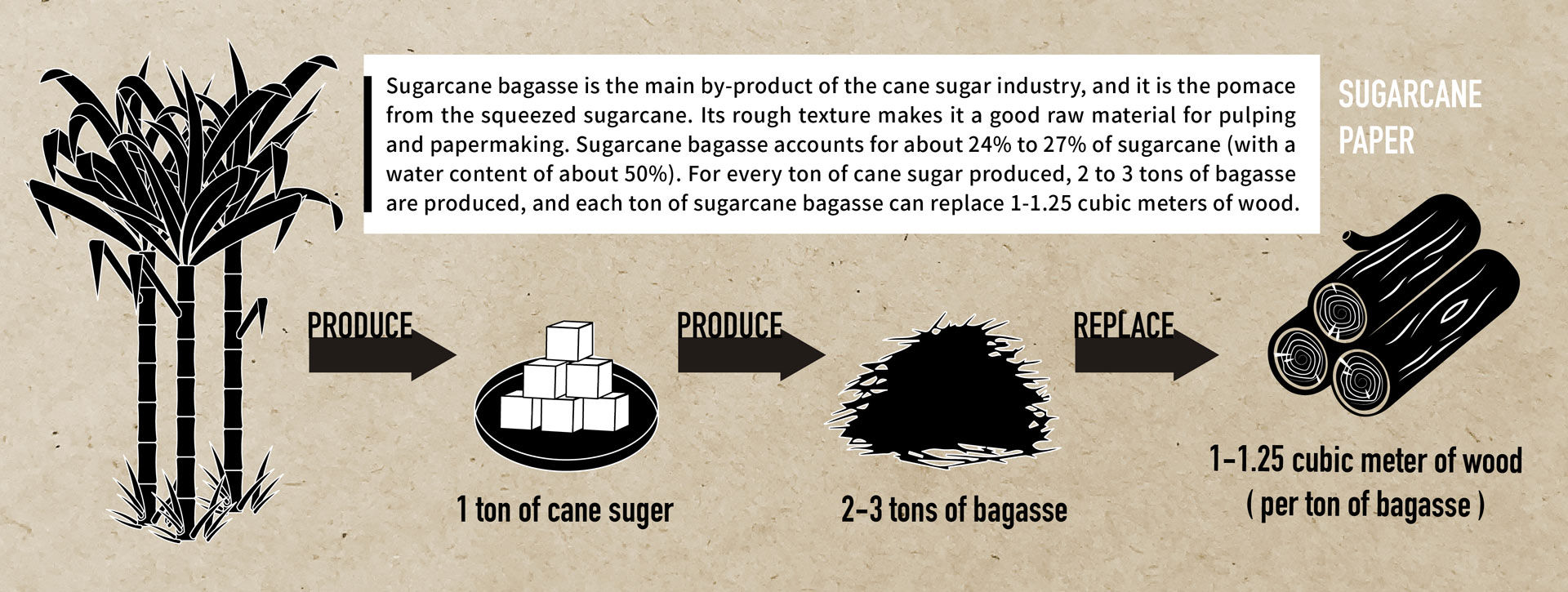
How is Sugarcane Paper Made?
Have you ever wondered that the bagasse of sugarcane you have eaten can still be used for papermaking? Before people realize that sugarcane bagasse is a precious renewable resource, it was just bio-waste. It has always been considered unusable and was thrown away or burned. But nowadays, bagasse is regarded as a valuable, renewable resource. Sugarcane bagasse is the main by-product of the cane sugar industry, and it is the pomace from the squeezed sugarcane. Its rough texture makes it a good raw material for pulping and papermaking. Sugarcane bagasse accounts for about 24% to 27% of sugarcane (with a water content of about 50%). For every ton of cane sugar produced, 2 to 3 tons of bagasse are produced, and each ton of sugarcane bagasse can replace 1-1.25 cubic meters of wood.  Bagasse is rich in cellulose, which is about 32%-48%. It is easy to cook and requires fewer chemicals than wood pulp paper for pulping. Therefore, the technology and equipment of bagasse pulping and alkali recovery process are more mature and simpler than other grass fiber materials, so sugarcane bagasse has great advantages as a fiber raw material. It is currently being used in several fields worldwide, including power production and tree-free paper production.
Bagasse is rich in cellulose, which is about 32%-48%. It is easy to cook and requires fewer chemicals than wood pulp paper for pulping. Therefore, the technology and equipment of bagasse pulping and alkali recovery process are more mature and simpler than other grass fiber materials, so sugarcane bagasse has great advantages as a fiber raw material. It is currently being used in several fields worldwide, including power production and tree-free paper production.
The Features and Benefits of Sugarcane Paper
Sugarcane can grow fast. Their height can exceed 3 meters in just one year and they reach full maturity in an average of 14 months, unlike trees must take at least 10 years. Furthermore, sugarcane releases 20.65 million tons of carbon dioxide in the field and during sugarcane processing, but the crop absorbs 228.89 million tons of carbon dioxide from the atmosphere during its life cycle. This shows that the sugarcane crop (5.32 million hectares) in addition to the carbon dioxide released by its respiration has also absorbed 208.24 million tons of additional carbon dioxide from the atmosphere. 
Sugarcane paper is a product with advantages such as being more eco-friendly and pollution-free than wood-pulp paper. Bagasse is usually burned after sugarcane is processed into cane sugar, which will cause extra pollution to the environment. We can turn it into the paper instead of processing or burning bagasse! It can also biodegrade and returns nutrients to the soil. Biodegradability ensures that a product can break down on its own over time. Sugarcane fiber can biodegrade within 30 to 90 days.
Sugarcane is a fibril so it doesn’t need to rebleach inks and dyes as recycled paper products. Unbleached natural fibers and colors will make the sugarcane paper more natural and more eco-friendly.
The Usages of Sugarcane Paper
Sugarcane paper does not require rebleaching of inks and dyes unlike recycled paper, and this will make the color of the paper look more natural. Compared with the unbleached kraft paper, it has more natural fiber textures, which makes the product packaging more outstanding and has a strong visual impact, especially for the Bio and Nature line products. Due to the sugarcane paper being a short fiber with low tearing, the thickness of the paper itself is limited, and the texture is softer. Compared with the firmness of kraft paper, sugarcane paper is more suitable for making the smaller packaging such as hangtags and cards. Today’s wastage is tomorrow’s shortage, so why don’t we use sugarcane paper which is made of sugarcane bagasse. It can help to breathe new life into sugarcane bagasse by repurposing them in the form of eco-friendliness. Related Topic:
Today’s wastage is tomorrow’s shortage, so why don’t we use sugarcane paper which is made of sugarcane bagasse. It can help to breathe new life into sugarcane bagasse by repurposing them in the form of eco-friendliness. Related Topic: 
